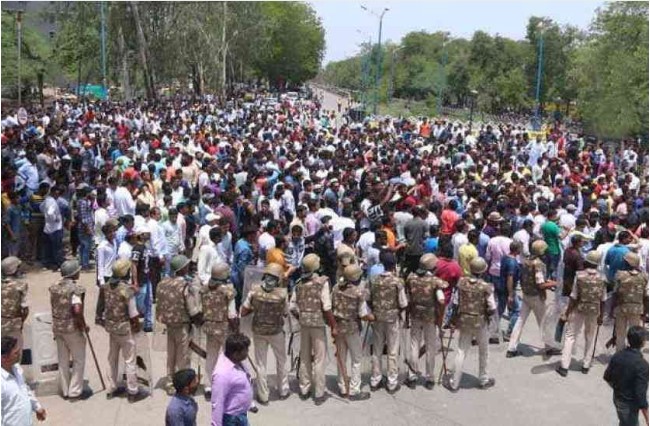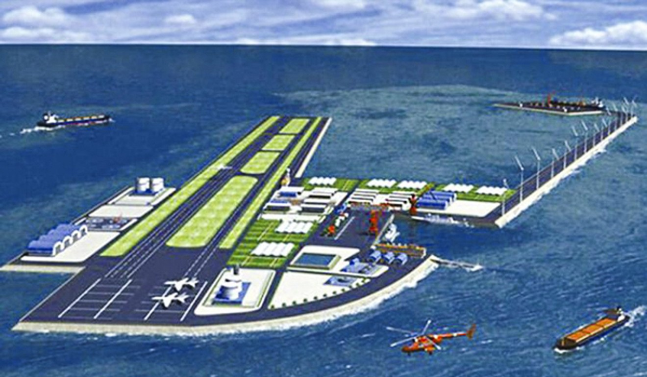Since 2006, John Kasarda, the most prominent proponent of aerotropolis developments, has published a plethora of articles extolling the supposed benefits of these megaprojects. The series begins with: Airport Cities and the Aerotropolis. In subsequent publications the same examples of aerotropolis-type projects crop up repeatedly, such as Schiphol, Frankfurt, Munich, Stockholm Arlanda in Europe, Hong Kong, Kuala Lumpur, Changi and Incheon in Asia, McCarran and Dallas/Fort Worth in the USA. Over the years some of the ambitious aerotropolis plans have been realised. Others are repeatedly stalled, in spite of heavy-handed intervention of governments designating large land areas and bestowing sweeping planning powers on airport-developer partnerships.

In the early months of 2020 Kasarda’s two-part global review of aerotropolis developments was published in Airport World, the magazine of Airports Council International (ACI), the global trade representative of the world’s airports. Part 1 Aerotropolis business magnets covers the Asia-Pacific region. Airports’ prodigious land ownership is emphasised in the second paragraph framing the aerotropolises featured in the article: ‘Airports themselves frequently contain thousands of acres of commerical real estate’.
Kasarda writes that China is ‘leading the way’. Airport-centric projects in China are indeed gargantuan. Beijing Capital Airport, ‘corner-stoned by its airport city logistics park (ACLP)’, is part of the 178 square kilometre Beijing Airport Core Economy Zone (BACEZ). Baiyun Airport provided a starting point for the city of Guangzhou’s aerotropolis development. This proved ‘slow to materialise due to inability to align local jurisdictions’, until the 116 square kilometre cross-jurisdictional Guangzhou Aerotropolis Development District (GADD) was established in September 2015. Zhengzhou Airport Economy Zone (ZAEZ) centred around Zhengzhou Xinzheng Airport is even larger, spanning 415 square kilometres.
Looking beyond China Kasarda highlights Incheon Airport, the main airport of Seoul, South Korea’s capital city, with ‘substantial commercial real estate development on its vast property’ filled with office complexes, hotels, resorts and logistics zones. Outside the airport fence development of the ‘greater aerotropolis’ is fostered by Incheon Free Zone extending over 209 square kilometres. In Malaysia, Kuala Lumpur Airport, KLIA Aeropolis is ‘expansive’, covering 100 square kilometres. But full development on an expansive land bank remains largely on the drawing board. KLIA Aeropolis is still ‘focussed on implementing plans’, even though a Kuala Lumpur airport city is hailed Kasarda’s aforementioned 2006 article as exemplifying ‘the new model of international airport development and management’. In India, Hyderabad Airport is ‘executing a theme-based airport city master plan consisting of six major commerical clusters… its 1,500 acre airport city includes a multi-produce special economic zone’. A grandiose sounding but more nebulous ‘greater Hyderabad Aerotropolis’ extends 10-20 kilometres outwards from the airport and is ‘dominated by IT and other high-tech, aviation-oriented sectors’.
A more recently conceived project is Western Sydney Aerotropolis. Plans were completed in 2019 and authorities have stepped in to fund the requisite surface transport links; the project is ‘backed by huge financial commitments by the central government for connecting rail and highway infrastructure’. In Thailand aerotropolis development is extending outward from U-Tapao Airport, a former US air base, and is a component of a much larger megaproject, the Eastern Economic Corridor (a special economic zone encompassing three provinces). In the Philippines investment in aerotropolis development at Clark Airport, another former US air base, is reported.
Over the years Kasarda began to acknowledge opposition to aerotropolis project from communities directly affected, by displacement due to land acquisition and negative environmental impacts. The 2020 article mentions that construction of another aerotropolis in the Philippines, in Bulacan, has been impeded by opposition to the environmental impacts, protests by fishermen. (Pamalakaya – National Federation of Small Fisherfolk Organization in the Philippines – is opposing the ‘undemocratic and unscientific’ Bulacan Aerotropolis project which would be ‘detrimental to the marine environment of Manila Bay’). Another example is the 4,500 hectare Taoyuan Aerotropolis in Taiwan (referred to by Kasarda as ‘Chinese Taipei’). Development was slowed down by protests over expropriation of farmland (see 2014 Ecologist article) but apparently concerns are being addressed by government bodies aiming to ‘jump start’ the government’s ‘flagship project’.

Part 2, Aerotropolis englines beyond Asia, looks at developments in Europe, the Americas, Africa and the Middle East. In France, Charles de Gaulle Airport has 1,340 hectares ‘dedicated to non-aeronautical development’ of which 600 hectares is already occupied by hotels, offices, retail and distribution facilities. This is the ‘epicentre’ of larger aerotropolis development around two airports: the Charles de Gaulle-Le Bourget Airport Area covers 420 square kilometres. Already there are 17 logistics parks, 85 business parks and two exhibition and convention complexes, along with 12,000 hotel rooms, in this area, described as ‘among the world’s fastest developing aerotropolises’. In Finland, a 42 square kilometre ‘Aviapolis’ is being developed around Helsinki Airport, enabled by a PPP (public-private partnership) between the city of Vantaa, airport operator Finavia and local landowners. Aviapolis already hosts 2,000 companies, a hotel cluster and ‘jumbo’ shopping centre.
Frankfurt Airport City contains the hotels, shops, restaurants, offices, leisure and exhibition facilities that are ubiquitous to airport-centric urbanism. Key components include Gateway Gardens (so heavily built up that there is little of the green space people might expect from this appellation) and the 75 hectare Mönchhof Logistics Park. The large footprint of the development area is highlighted, Mönchhof is ‘reputedly the largest contiguous block of logistically zoned land being constructed in the Rhine-Main region’. Munich Airport is ‘developing a future-oriented innovation campus on 500,000sqm of land’. No surprise at this description, such developments are never hailed as backward-looking and imitative.
Aerotropolis development in the US is characterised by allocation of large areas of land for airport-linked development. Dallas/Fort Worth Airport covers nearly 69 square kilometres and at this juncture 2,428 hectares of airport property designated for commerce and industry has been developed, most recently a business park and a 223,000 square metre Amazon ‘fulfillment centre’. At 137 square kilometers Denver Airport’s site is even larger, containing ‘vast expanses of open land’ for aerotropolis development. After a decade of inactivity airport-centric development in the Detroit Region has been galvanised by support from the Aerotropolis Detroit Region Aerotropolis Development Corporation, which ‘mobilised fiscal resources to promote 60,000 developable acres’ around Detroit Metro Airport.
No details are given about what is actually happening at Alberta, Edmonton and Vancouver airports, stated to be ‘at the forefront’ of aerotropolis development in Canada. Another major aerotropolis is planned around the proposed new airport in Pickering, but this airport is long-delayed as ‘environmentalists still fight the project’ (opposition to this airport, taking up a vast area of productive farmland, has been led by Land Over Landings since 2005). Aerotropolis development at Tocumen Airport in Panama, and Belo Horizonte Airport in Brazil has been impeded by ‘political and economic disruptions’. Contractors involved in construction of the New Mexico City Airport, cancelled in 2018, benefitted from $4.5 billion in compensation awarded by Mexico City’s airport authority.
In South Africa, an airport city at Johannesburg Airport consisting of three commercial precincts is reported to be ‘forming’, based on a 2015 master plan for a 30 kilometre radius around the airport. A large area is earmarked for Durban Aerotropolis, centred upon King Shaka International Airport (KSIA); ‘about 8,000 developable hectares radiate from KSIA’. But as of 2019 development was still a the ‘planned’ stage, 4,200 hectares of commercial development and over 130,000 residential units.
Several Middle East countries have ‘stated ambitions to develop airport cities at their primary air gateways and aerotropolises around them’, including Abu Dhabi, Egypt, Iran, Saudi Arabia, Turkey and Qatar. Only Dubai ‘followed through and went big’. Terminal 3 – encompassing duty-free shops, hotels and leisure facilities – itself constitutes an airport city and there is also a substantial Free Zone comprising distribution centres, offices, light manfacturing and a temperature-controlled centre for perishable cargo.
Dubai’s second airport, Al Maktoum, opened in 2013, was intended to ‘anchor’ a gigantic 145 square kilometer aerotropolis called Dubai South. There are elaborate plans for ‘eight surrounding aerotropolis districts focusing on Aviation Industry, Logisitcs, Residential, Golf, Commerical, Humanitarian, and Exhibition (World Expo 2020 for instance) functions plus Dubai Business Park’ around what was anticipated to become the world’s busiest airport. By 2019 1,200 firms were located at Dubai South but further development, dependent upon plans to shift much of Dubai Airport’s traffic to Al Maktoum, is ‘likely to be impacted’ due to declining growth of Emirates Airline’s passenger traffic. Al Maktoum Airport is a long way from becoming the world’s busiest airport. By 2019 the mega airport had capacity to handle 26.5 million passengers per year but after handling less than 1 million passengers in 2018 had ‘very limited traffic’ except for ‘quite a few cargo planes’.
Al Maktoum Airport and Dubai South were well-positioned to play a key role in World Expo 2020. Then came the coronvirus pandemic. World Expo 2020 and similar global events were cancelled and the aviation industry spiralled downwards in an unprecendented collapse. According to the strapline Part 2 of Kasarda’s 2020 aerotropolis status report ‘considers the implications of the coronavidus pandemic on aviation and future development’. The dramatic reduction in air traffic, plummeting by as much as 90 per cent in April 2020 compared to the previous year, is noted and he acknowledges ‘near empty passenger terminals and investment in commercial zones surrounding airports stalling, coming to a ‘virtual standstill’. Yet Kasarda predicts resumption of aviation growth, with air traffic ‘rebounding in the years afterwards to new heights’ and foresees ‘airport cities and their greater aerotropolises taking on ever more importance’.
Kasarda’s confidence that the ‘long term growth trends’ of airports and the aerotropolis will resume in the wake of the COVID-19 crisis, as was seen after the SARS (Severe Acute Respiratory Syndrome) outbreak in 2003, is unwarranted. SARS affected 26 countries, resulting in over 8,000 cases and 800 deaths. SARS was contained and effectively eradicated. At the time of writing the number of confirmed COVID-19 cases has reached 5,593,631 and 353,334 people are known to have died from the disease. Only a few countries have not yet reported any coronavirus cases. The number of infections and deaths is on a frightening upward trajectory and the ‘resolutions of the coronavirus pandemic’ Kasarda assumes will occur are not yet on the horizon.








